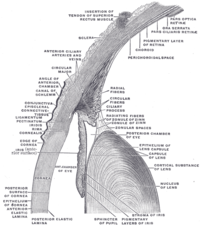
Photo from wikipedia
Abstract To build a biomechanical numerical model of the nasopharynx, construct an accurate computerized numerical description of its specific anatomical structures, analyze the distribution of air flow field, starting with… Click to show full abstract
Abstract To build a biomechanical numerical model of the nasopharynx, construct an accurate computerized numerical description of its specific anatomical structures, analyze the distribution of air flow field, starting with the anatomical structure of the pharyngeal recess, correlate its anatomical characteristics with the occurrence and development of nasopharyngeal carcinoma from the perspective of biomechanics. In this study, the nasal and nasopharyngeal cavities of healthy male adult, with the pharyngeal recess in an open state, were scanned by CT to obtain DICOM imaging data. Then, they were imported into Mimics 20.0 to build a model which was recorded in binary STL format. Each file was imported into Geomagic studio 12.0 to construct a 3D model saved in an IGES format. Then, it was imported into ANSYS Workbench for numerical simulation of air flow field. The authors found that:1. The pressure gradient in nasopharyngeal cavity was, located within pharyngeal recess opening, posterior wall of nasopharyngeal cupula and bottom of nasopharynx, accounting for 55%, 30%, and 15% of total, respectively.2. Over respiratory cycle, the peripheral region of the opening of pharyngeal recess and posterior wall of nasopharyngeal cupula persistently exhibited low-velocity regions and vortices, with velocities of 1.1 m/s and 1.5 m/s, respectively. Above all, the causes and pathogenesis of nasopharyngeal carcinoma can be identified from the perspective of biomechanics through the construction of a 3D model and analysis of the characteristics of air flow field. With more in-depth research, it is expected that a more solid scientific foundation will be created for related quantitative analysis.
Journal Title: Journal of Craniofacial Surgery
Year Published: 2020
Link to full text (if available)
Share on Social Media: Sign Up to like & get
recommendations!